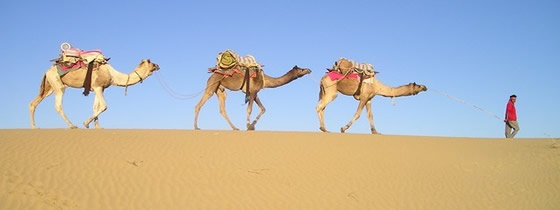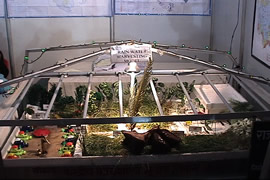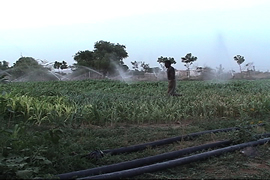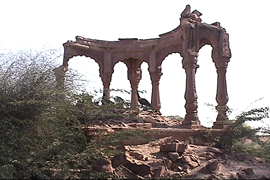Spitting in the Wind:
Combatting Desertification in the Great Indian Desert
By Brook & Gaurav Bhagat

There are very few elements which are absolutely essential to life on Earth-- broadly speaking, they are air, food and water, and without any one of these, survival is impossible.
Deserts are characterized by their lack of water (less than 500 mm annual rainfall). Arid and semi-arid regions constitute one third of the Earth's land area, according to recent statistics (FAO, UNCOD, UNESCO, 2001), and they are growing at an alarming rate. This process, called desertification, currently threatens the survival of almost one fifth of the world's human population, not to mention plant and animal life.
On the limited evidence available it would appear on a global average that almost 60% of rain fed croplands are affected by desertification to some extent-- 28% moderately, 20% severely and 11.6% very severely.
Almost half of irrigated land is severely or very severely desertified (J.A. Mabbutt, Assessment of the Status and Trend of Desertification).
The Thar Desert, also known as the Great Indian Desert, covers 77,000 square miles of Pakistan and Rajasthan, the western most state of India. It is characterized by its massive rolling sand dunes, excessive heat (50 degrees centigrade in May and June, with sand temperatures rising to 70 degrees), dust storms and dust-raising winds, often blowing winds with velocities of 140-150 Km/hr.
The annual average rainfall is less than 10 inches (250 mm); 90% of this rain occurs during the Monsoon or "rainy season," falling between July and September. Water is scarce, but is found at the depth of 100-200 feet below ground.
Thar Desert vegetation must be extremely hearty to endure such conditions; it is mostly herbaceous, or of stunted scrub; on the hills, small bushes like gum arabic acacia and euphorbia may be found. The Khejari tree (prosopis cineraria) grows widely throughout the plains, and other trees occasionally dot the horizon as well.
Arid Forest Research Institute, one of eleven institutes of the Indian Council of Forestry Research and Education (ICFRE) was established in 1988 with the aim of understanding and combating desertification with a multi-dimensional approach, according to Naveen Bohra, who has been working as a research assistant at AFRI for more than 10 years.

Bohra said the thrust areas of research at AFRI are mainly to develop techniques for rainwater harvesting, to develop and improve agri-silvi-pastoral systems, develop technology for afforestation on stress sights and the eco-stabilization of deserts, with an emphasis on sand dune fixation.
Other goals include developing, producing, and distributing high quality planting material to local farmers, performing "Provenance Trials" of important arid zone species, improving trees through tissue-culture and genetic engineering, and researching non-wood forest products, especially those with medicinal value.
"We encourage people to grow crops of medicinal value, like Sona-mukhi (cassia angusta folia), which needs very little water and requires no protection from animals, " Bohra said.
The main factors responsible for desertification in the Thar Desert of Rajasthan are climatic-- the high temperature, low rainfall and high wind velocity-- biotic, and socio-economic.
Biotic causes include overgrazing of livestock (cattle alone outnumber humans 2 to 1), intensive crop cultivation, forest removal for the purpose of mining and general indiscriminate deforestation and exploitation of natural resources.
Socio-economic factors include poverty, illiteracy and tradition-bound cultural practices. In almost every aspect of village life, firewood is a necessity-- from the Hindu ceremonies celebrating birth and marriage, every day ordinary cooking, to the final funeral pyre.
An AFRI case study done on 10 villages representative of desert life revealed the ratio of livestock to human population to be 1:72, indicating high biotic pressure on forest vegetation. The average family size was found to be 6.5, land holdings at 5.2 hectares, and per capita income only US $105 (RS. 5100) per month, reflecting a poor economy, and literacy ranged from 36 to 38%.
Twice a year, AFRI holds "Farmer Fairs" to let progressive farmers know about new developments. "AFRI provides technology, developed plants, bio-pesticides and other material at a nominal cost or free of cost," said Bohra.

Vinod Sahni, also an AFRI research assistant, joined the conversation. "Many achievements of AFRI, like developing bio-pesticides from the neem tree (azadiraclita indica), help people directly. Usually they use chemicals which leave a bad effect on people, soil and plants but the bio pesticides using neem are eco-friendly. It was developed in the first five years of AFRI, and was launched in the market after '95. Now it’s worldwide."
In other research performed here, we did an international provenance trial on neem. This is only at AFRI. We collected seeds from different sources from around the world, planted them here and checked which one grows the best in this environment, considering many averages, genetic parameters, time, survival, quality and ability to adapt to the new climate and then multiplied a plantation of that particular species." Sahni said.
Acaida and Rohira were on national provenance trial, and have now also been grown on a large scale. Bohra described the necessity of agro-forestry in the region: "in this region nobody is growing only crops or only forest plants. If they grow only crops there may be no rain fall during the season and then they have nothing to survive on but if they grow some forest plant or some medicinal/business oriented plants, they can at least feed their livestock, for example Khejari and other leguminous plants or sona-mukhi as medicinal plant." Another benefit of Khejari and other leguminous plants is that They fix nitrogen into nitrate, which is helpful for both trees and crops.
AFRI is a globally thinking institution; externally funded research projects include the RD project (1995-2000), NABARD project (1995-2000), UNDP project (1992-2000), WB project (1994-continuing) and NOVOD (1999-continuing).
About these internationally funded projects Sahni said, "UNDP (United Nations Development Program) was conducted in 10 villages of this area from 1992 to 2000. In that program, we were bringing the upgraded plantation to the villages, showing new techniques of rain-water harvesting and trying to apply them there. If water is there, this desert can be made into a forest."
A few developments or achievements of this program are:
1. The development of the double ring pit and the use of mulch-- dead weeds or other organic material-- which make it possible for the plant to get water longer.
2. The use of root trainer, i.e., plastic pots in a tray with holes, instead of polythene bags provides a good root system and no root coiling.
3. The use of bio-fertilizers called VAM (vesicular arbuscular mycorrhizer), special type of organism which increases the phosphorus intake of plants which is one of the three main elements a plant needs.
"VAM is popular around the world in many types, and more are being developed, as it increases plant fertility," Bohra said.
One of AFRI's biggest achievements, as there are many industries in this region and their waste-water is flowing uselessly, destroying the land and the environment around it with its high percentage of chemicals, is the development of certain techniques for using that wastewater and protecting the people from drinking it: after mixing gypsum, the PH or acidic nature is reduced, and adding wood ash keeps the fertility of the ground intact.

"The neem, sares, and desi babool plants can be grown, as per our studies, to survive successfully on this wastewater, and then the water can be used before reaching a river and contaminating the good drinking water of river areas," Sahni said.
About the socio-economic status of Rajasthan, Sahni said it's progressing slowly.
AFRI is a consultant in sand-dune stabilization, rain-water harvesting, crop development, the development of medicinal plants and the development of agro-forestry, which provides techniques and knowledge about growing crops with fruits and medicinal plants in an agro-forestry system.
AFRI is researching combating desertification with the use of sprinklers and a silvi-pastoral project for sand-dune stabilization, which means developing a good crop of grasses that, even in the case of draught, the root system may remain after the plant dies, keeping the sand-dune intact and preventing it from moving.
Another method of preventing desertification is shelter belt plantation, i.e., planting a line of trees to reduce the effect of wind and minimize wind erosion.
The Thar Desert in India is full of ironies—one of them being the Bishnoi community of Rajasthan. The Bishnois worship nature in all its manifestations. Not the ripe, yielding nature of ancient pagan societies, but the ruthless and demanding desert.
Amrita Devi was a Bishnoi woman who, along with more than 366 other Bishnois, died saving trees. About 200 years back, Maharaja Abhay Singh of Jodhpur required wood for his palace. So he sent his soldiers to cut trees. Amrita Devi and other villagers hugged the branches while the soldiers chopped them down with the trees. This is still remembered as the great Khejarli sacrifice.
In fact the name of that tree was Khejari (prosopis cineraria) and after this incident that village was called Khejarli in the memory of those who died. In their story we can see something of the true spirit of ecology, or love for the Earth, which has been so lacking in the 200 years since.
There is reason to believe, however, that there is still time to save this planet and its inhabitants; while the desert winds continue to blow, more and more people are thinking about global ecological challenges, and at places like AFRI, they are actually doing something about them.
Did you like the article? Subscribe here to our New Article Email Alert or RSS feeds.
Sharing is caring! Don't forget to share the love, and keep the conversation going by leaving a comment below:
Advertisement
